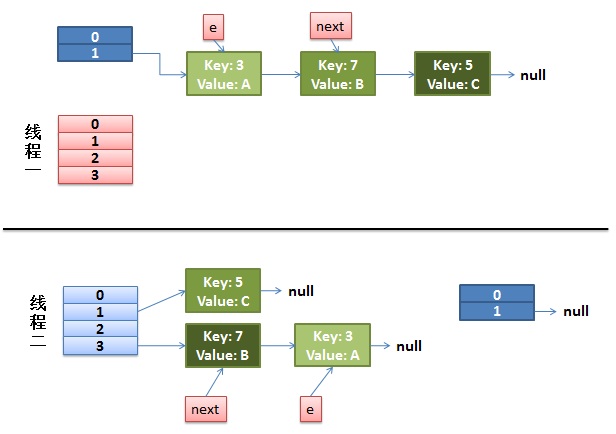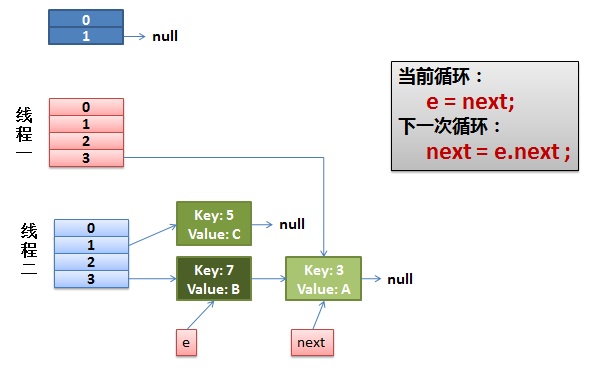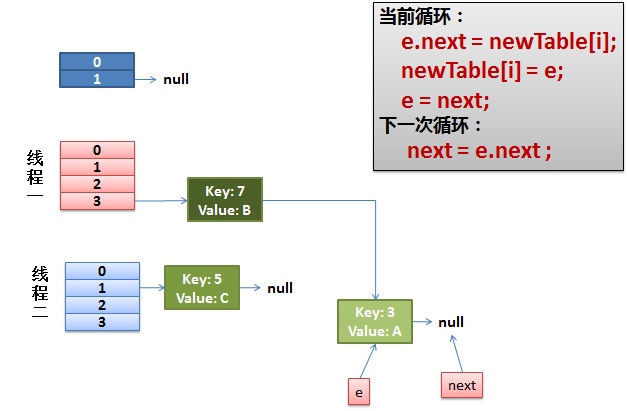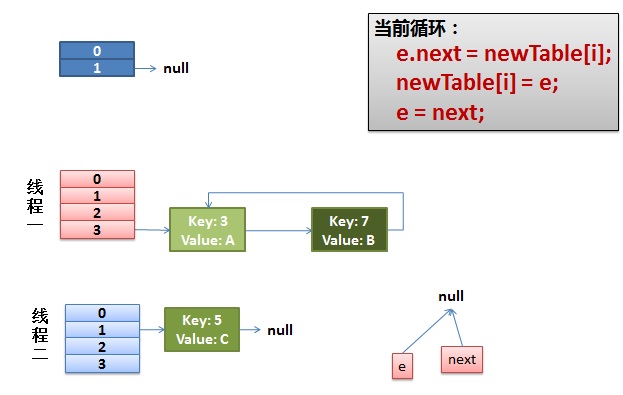我们都知道,HashMap在并发环境下使用可能出现问题,但是具体表现,以及为什么出现并发问题,
可能并不是所有人都了解,这篇文章记录一下HashMap在多线程环境下可能出现的问题以及如何避免。
在分析HashMap的并发问题前,先简单了解HashMap的put和get基本操作是如何实现的。
1.HashMap的put和get操作
大家知道HashMap内部实现是通过拉链法解决哈希冲突的,也就是通过链表的结构保存散列到同一数组位置的两个值,
put操作主要是判空,对key的hashcode执行一次HashMap自己的哈希函数,得到bucketindex位置,还有对重复key的覆盖操作。
对照源码分析一下具体的put操作是如何完成的:
|
1
2
3
4
5
6
7
8
9
10
11
12
13
14
15
16
17
18
19
20
21
22
23
24
25
|
public
V put(K key, V value) {
if
(key ==
null
)
return
putForNullKey(value);
//得到key的hashcode,同时再做一次hash操作
int
hash = hash(key.hashCode());
//对数组长度取余,决定下标位置
int
i = indexFor(hash, table.length);
/**
* 首先找到数组下标处的链表结点,
* 判断key对一个的hash值是否已经存在,如果存在将其替换为新的value
*/
for
(Entry<K,V> e = table[i]; e !=
null
; e = e.next) {
Object k;
if
(e.hash == hash && ((k = e.key) == key || key.equals(k))) {
V oldValue = e.value;
e.value = value;
e.recordAccess(
this
);
return
oldValue;
}
}
modCount++;
addEntry(hash, key, value, i);
return
null
;
}
|
涉及到的几个方法:
|
1
2
3
4
5
6
7
8
|
static
int
hash(
int
h) {
h ^= (h >>>
20
) ^ (h >>>
12
);
return
h ^ (h >>>
7
) ^ (h >>>
4
);
}
static
int
indexFor(
int
h,
int
length) {
return
h & (length-
1
);
}
|
数据put完成以后,就是如何get,我们看一下get函数中的操作:
|
1
2
3
4
5
6
7
8
9
10
11
12
13
14
15
|
public
V get(Object key) {
if
(key ==
null
)
return
getForNullKey();
int
hash = hash(key.hashCode());
/**
* 先定位到数组元素,再遍历该元素处的链表
* 判断的条件是key的hash值相同,并且链表的存储的key值和传入的key值相同
*/
for
(Entry<K,V> e = table[indexFor(hash, table.length)];e !=
null
;e = e.next) {
Object k;
if
(e.hash == hash && ((k = e.key) == key || key.equals(k)))
return
e.value;
}
return
null
;
}
|
看一下链表的结点数据结构,保存了四个字段,包括key,value,key对应的hash值以及链表的下一个节点:
|
1
2
3
4
5
6
|
static
class
Entry<K,V>
implements
Map.Entry<K,V> {
final
K key;
//Key-value结构的key
V value;
//存储值
Entry<K,V> next;
//指向下一个链表节点
final
int
hash;
//哈希值
}
|
2.Rehash/再散列扩展内部数组长度
哈希表结构是结合了数组和链表的优点,在最好情况下,查找和插入都维持了一个较小的时间复杂度O(1),
不过结合HashMap的实现,考虑下面的情况,如果内部Entry[] tablet的容量很小,或者直接极端化为table长度为1的场景,那么全部的数据元素都会产生碰撞,
这时候的哈希表成为一条单链表,查找和添加的时间复杂度变为O(N),失去了哈希表的意义。
所以哈希表的操作中,内部数组的大小非常重要,必须保持一个平衡的数字,使得哈希碰撞不会太频繁,同时占用空间不会过大。
这就需要在哈希表使用的过程中不断的对table容量进行调整,看一下put操作中的addEntry()方法:
|
1
2
3
4
5
6
|
void
addEntry(
int
hash, K key, V value,
int
bucketIndex) {
Entry<K,V> e = table[bucketIndex];
table[bucketIndex] =
new
Entry<K,V>(hash, key, value, e);
if
(size++ >= threshold)
resize(
2
* table.length);
}
|
这里面resize的过程,就是再散列调整table大小的过程,默认是当前table容量的两倍。
|
1
2
3
4
5
6
7
8
9
10
11
12
13
14
|
void
resize(
int
newCapacity) {
Entry[] oldTable = table;
int
oldCapacity = oldTable.length;
if
(oldCapacity == MAXIMUM_CAPACITY) {
threshold = Integer.MAX_VALUE;
return
;
}
Entry[] newTable =
new
Entry[newCapacity];
//初始化一个大小为oldTable容量两倍的新数组newTable
transfer(newTable);
table = newTable;
threshold = (
int
)(newCapacity * loadFactor);
}
|
关键的一步操作是transfer(newTable),这个操作会把当前Entry[] table数组的全部元素转移到新的table中,
这个transfer的过程在并发环境下会发生错误,导致数组链表中的链表形成循环链表,在后面的get操作时e = e.next操作无限循环,Infinite Loop出现。
下面具体分析HashMap的并发问题的表现以及如何出现的。
3.HashMap在多线程put后可能导致get无限循环
HashMap在并发环境下多线程put后可能导致get死循环,具体表现为CPU使用率100%,
看一下transfer的过程:
|
1
2
3
4
5
6
7
8
9
10
11
12
13
14
15
16
17
18
|
void
transfer(Entry[] newTable) {
Entry[] src = table;
int
newCapacity = newTable.length;
for
(
int
j =
0
; j < src.length; j++) {
Entry<K,V> e = src[j];
if
(e !=
null
) {
src[j] =
null
;
do
{
//假设第一个线程执行到这里因为某种原因挂起
Entry<K,V> next = e.next;
int
i = indexFor(e.hash, newCapacity);
e.next = newTable[i];
newTable[i] = e;
e = next;
}
while
(e !=
null
);
}
}
}
|
这里对并发情况的描述起来比较绕,先偷个懒,直接引用酷壳陈皓的博文:
并发下的Rehash
1)假设我们有两个线程。我用红色和浅蓝色标注了一下。
我们再回头看一下我们的 transfer代码中的这个细节:
do{Entry<K,V> next = e.next;// <--假设线程一执行到这里就被调度挂起了inti = indexFor(e.hash, newCapacity);e.next = newTable[i];newTable[i] = e;e = next;}while(e !=null);而我们的线程二执行完成了。于是我们有下面的这个样子。
注意,因为Thread1的 e 指向了key(3),而next指向了key(7),其在线程二rehash后,指向了线程二重组后的链表。我们可以看到链表的顺序被反转后。
2)线程一被调度回来执行。
- 先是执行 newTalbe[i] = e;
- 然后是e = next,导致了e指向了key(7),
- 而下一次循环的next = e.next导致了next指向了key(3)
3)一切安好。
线程一接着工作。把key(7)摘下来,放到newTable[i]的第一个,然后把e和next往下移。
4)环形链接出现。
e.next = newTable[i] 导致 key(3).next 指向了 key(7)
注意:此时的key(7).next 已经指向了key(3), 环形链表就这样出现了。
于是,当我们的线程一调用到,HashTable.get(11)时,悲剧就出现了——Infinite Loop。
针对上面的分析模拟这个例子,
这里在run中执行了一个自增操作,i++非原子操作,使用AtomicInteger避免可能出现的问题:
|
1
2
3
4
5
6
7
8
9
10
11
12
13
14
15
16
17
18
19
20
21
22
|
public
class
MapThread
extends
Thread{
/**
* 类的静态变量是各个实例共享的,因此并发的执行此线程一直在操作这两个变量
* 选择AtomicInteger避免可能的int++并发问题
*/
private
static
AtomicInteger ai =
new
AtomicInteger(
0
);
//初始化一个table长度为1的哈希表
private
static
HashMap<Integer, Integer> map =
new
HashMap<Integer, Integer>(
1
);
//如果使用ConcurrentHashMap,不会出现类似的问题
// private static ConcurrentHashMap<Integer, Integer> map = new ConcurrentHashMap<Integer, Integer>(1);
public
void
run()
{
while
(ai.get() <
100000
)
{
//不断自增
map.put(ai.get(), ai.get());
ai.incrementAndGet();
}
System.out.println(Thread.currentThread().getName()+
"线程即将结束"
);
}
}
|
测试一下:
|
1
2
3
4
5
6
7
8
9
10
11
12
13
14
15
16
17
18
19
20
21
22
23
24
|
public
static
void
main(String[] args){
MapThread t0 =
new
MapThread();
MapThread t1 =
new
MapThread();
MapThread t2 =
new
MapThread();
MapThread t3 =
new
MapThread();
MapThread t4 =
new
MapThread();
MapThread t5 =
new
MapThread();
MapThread t6 =
new
MapThread();
MapThread t7 =
new
MapThread();
MapThread t8 =
new
MapThread();
MapThread t9 =
new
MapThread();
t0.start();
t1.start();
t2.start();
t3.start();
t4.start();
t5.start();
t6.start();
t7.start();
t8.start();
t9.start();
}
|
注意并发问题并不是一定会产生,可以多执行几次,
我试验了上面的代码很容易产生无限循环,控制台不能终止,有线程始终在执行中,
这是其中一个死循环的控制台截图,可以看到六个线程顺利完成了put工作后销毁,还有四个线程没有输出,卡在了put阶段,感兴趣的可以断点进去看一下:

上面的代码,如果把注释打开,换用ConcurrentHashMap就不会出现类似的问题。
4.多线程put的时候可能导致元素丢失
HashMap另外一个并发可能出现的问题是,可能产生元素丢失的现象。
考虑在多线程下put操作时,执行addEntry(hash, key, value, i),如果有产生哈希碰撞,
导致两个线程得到同样的bucketIndex去存储,就可能会出现覆盖丢失的情况:
|
1
2
3
4
5
6
7
|
void
addEntry(
int
hash, K key, V value,
int
bucketIndex) {
//多个线程操作数组的同一个位置
Entry<K,V> e = table[bucketIndex];
table[bucketIndex] =
new
Entry<K,V>(hash, key, value, e);
if
(size++ >= threshold)
resize(
2
* table.length);
}
|
5.使用线程安全的哈希表容器
那么如何使用线程安全的哈希表结构呢,这里列出了几条建议:
使用Hashtable 类,Hashtable 是线程安全的;
使用并发包下的java.util.concurrent.ConcurrentHashMap,ConcurrentHashMap实现了更高级的线程安全;
或者使用synchronizedMap() 同步方法包装 HashMap object,得到线程安全的Map,并在此Map上进行操作。





























 被折叠的 条评论
为什么被折叠?
被折叠的 条评论
为什么被折叠?








